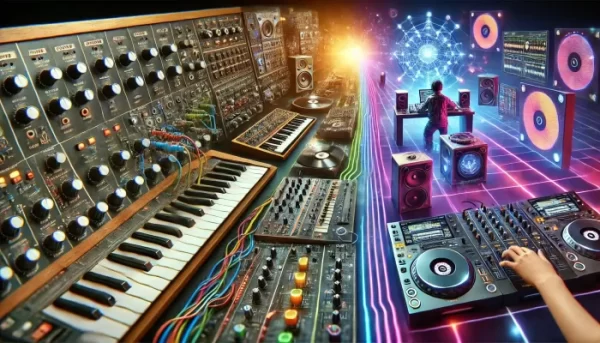Electronic music is more than just sound—it’s a technological revolution, a cultural movement, and a constantly evolving art form. From the clunky analog synthesizers of the 1960s to the high-tech performances of today’s DJs, electronic music has transformed the way we experience rhythm, melody, and dance.
In this article, we’ll take a journey through the fascinating evolution of electronic music, explore its key moments, technologies, and figures, and glimpse into what the future might hold.
The Analog Era: Where It All Began
The roots of electronic music can be traced back to the early 20th century with experimental instruments like the Theremin and the Ondes Martenot, but it wasn’t until the 1950s and 60s that it began to take recognizable shape.
The development of analog synthesizers marked a turning point. These machines, using voltage-controlled oscillators and filters, allowed musicians to create entirely new sounds.
Moog Synthesizer: The Game-Changer
In 1964, Robert Moog introduced one of the first commercially available analog synthesizers. The Moog Synthesizer quickly found its way into the hands of adventurous musicians. Bands like The Beatles, Pink Floyd, and Kraftwerk began incorporating synth sounds into their work, giving birth to a new musical landscape.
Unlike traditional instruments, synthesizers could bend sound—stretching, distorting, and reshaping it into futuristic tones. It was music made by machines, yet driven by human creativity.
Kraftwerk and the Rise of Electro Pop
In the 1970s, Kraftwerk, a group from Germany, took electronic music to the next level. Their minimalist style, robotic voices, and mechanical rhythms created a cold yet hypnotic sound that would inspire countless genres.
They were among the first to fully embrace a computer-like aesthetic in music, paving the way for electro, synth-pop, and even hip-hop beats that would sample their work in later decades.
Kraftwerk’s influence can be heard in artists like Daft Punk, Depeche Mode, and even Dr. Dre. They didn’t just make music—they built a new sonic identity.
The Digital Revolution: Drum Machines and Sampling
In the 1980s and 90s, electronic music took another leap forward with the invention of digital synthesizers, drum machines, and sampling technology.
The Roland TR-808 and TR-909 became essential tools in the hands of producers. Their distinctive kick and snare sounds defined entire genres like house, techno, and hip-hop.
Sampling—taking small snippets of existing recordings and repurposing them—opened up a universe of possibilities. Musicians could now build songs using fragments of other tracks, layering them in unexpected ways.
Genres like breakbeat, jungle, and drum and bass emerged from these new techniques, offering high energy, rapid rhythms, and deep basslines.
The DJ Culture and Rave Scene
While producers crafted music in studios, a new kind of performer emerged: the DJ.
In the late 1980s and 1990s, DJs became the stars of underground rave scenes, especially in the UK, Germany, and the United States. With vinyl records, turntables, and mixers, they blended tracks into seamless journeys, transforming nightclubs and warehouses into electric experiences.
This period gave rise to global electronic music events like Love Parade, Creamfields, and later, Tomorrowland and Ultra Music Festival. Electronic music has become a lifestyle, not just a genre.
The EDM Boom and Mainstream Explosion
In the 2010s, Electronic Dance Music (EDM) exploded into the mainstream. Artists like Calvin Harris, David Guetta, Avicii, and Skrillex brought electronic music to radio, television, and pop charts.
This era was marked by massive drops, singalong hooks, and bright, festival-ready sounds. Electronic music was no longer niche—it was now the sound of global pop.
The boom also highlighted the role of the producer-DJ as both creator and performer. Armed with laptops and MIDI controllers, modern DJs became digital conductors, controlling sound, visuals, and lighting in real time.
The Technology Behind the Sound
Modern electronic music is powered by DAWs (Digital Audio Workstations) like Ableton Live, FL Studio, and Logic Pro. These platforms allow producers to compose, edit, and mix entire tracks on a laptop.
Plugins and virtual instruments offer endless sound possibilities. Meanwhile, hardware like modular synthesizers, samplers, and controllers give artists hands-on control.
AI is also entering the mix. Tools like AI-generated loops, auto-mixing software, and real-time pitch correction are changing how music is made and performed.
The DJs of the Future
So, what comes next?
The future of electronic music lies in innovation and hybridization. We’re seeing:
- Immersive audio experiences with 3D sound and spatial mixing.
- Virtual reality raves and metaverse concerts where avatars dance to live DJ sets.
- AI-powered tools that suggest harmonies, beats, or even write full tracks.
- Live shows blending holograms, interactive visuals, and motion tracking.
- DJs and producers who act as multi-sensory artists, controlling not only the music but the entire environment.
New genres are also emerging, like hyperpop, future garage, and ambient techno, showing that the boundaries of electronic music are still expanding.
A Genre Without Limits
Electronic music has never been static. It evolves with technology, adapts to new cultures, and thrives on collaboration and experimentation.
From the analog warmth of the Moog synth to the algorithmic beats of AI, electronic music continues to push the boundaries of what sound can be. It’s not just music for dancing—it’s a soundtrack to the digital age.
Whether you’re in a dark club, a massive festival, or wearing headphones in your room, electronic music connects people through rhythm and emotion. It speaks to the past, the present, and most excitingly, the future.

